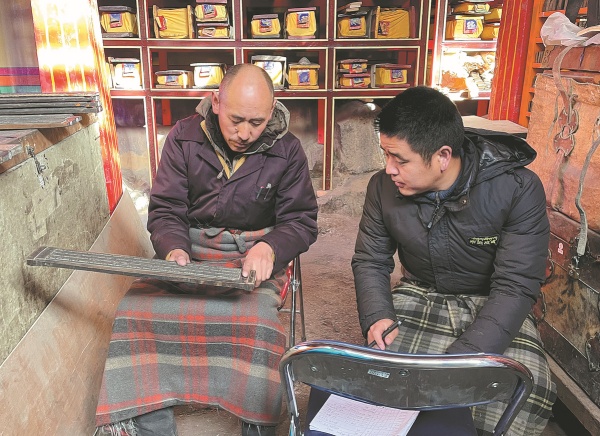Xizang sees progress in palace protection
Updated: 2024-12-18 By Palden Nyima and Daqiong in Lhasa (China Daily)  Print
Print 



Yangdrungthar (right), a researcher at the cultural relics office of the Potala Palace, consults with an ancient literature expert on identifying the content of the printing woodblock in Lhasa, Xizang autonomous region, in January. [Photo by Palden Nyima/China Daily]
Tuesday marked the 30th anniversary of the designation of the Potala Palace in the Xizang autonomous region as a UNESCO World Heritage site, a milestone celebrated with ongoing efforts to preserve and digitize its cultural treasures.
Over the past three decades, the Chinese government has allocated nearly 800 million yuan ($109 million) for preservation projects, Xinhua News Agency reported. These include major renovations to the palace's structure, investments in ticketing systems and the preservation of ancient texts, according to officials at the Potala Palace Management Office.
Among the initiatives, nearly 1,000 thangka paintings have been cataloged, appraised and scanned in high definition since digitization efforts began in March, said Palden Tsering, a cultural relics librarian at the palace.
The palace, located in the regional capital of Lhasa, houses more than 6,000 thangka paintings spanning various historical periods. These works depict Buddhist stories, Tibetan history and culture, biographies of prominent figures, Tibetan medicine and traditional craftsmanship, Palden said.
Efforts to preserve other relics have also advanced. Since July 2023, researchers have completed documentation of the palace's 39,811 wooden carvings, including 1,718 classified as precious, according to Yangdrungthar, a researcher at the cultural relics office.
"This process has ensured a comprehensive and systematic record of the cultural relics," Yangdrungthar said, adding that digital documentation has enhanced research and preservation.
The preservation of palm-leaf manuscripts — ancient Buddhist scriptures engraved on pattra leaves — has been a focus since 2019, when the palace established a restoration group. Palm-leaf scriptures, regarded as first-class cultural relics in China, are part of the world's largest collection of such manuscripts, with the most significant examples housed at the Potala Palace.
"Given the lack of restoration methods globally, we've been documenting and analyzing the condition of these manuscripts to prepare for large-scale restoration efforts," said Pema Dekyi, an ancient manuscript restoration specialist.
Built in the seventh century by Tibetan King Songtsen Gampo and expanded in the 17th century under the fifth Dalai Lama, the Potala Palace has stood as a cultural and architectural landmark for over 13 centuries.
Kunga Tashi, deputy director of the Potala Palace Management Office, said the palace reflects the diverse interactions and cultural exchanges among ethnic groups in China. Since 2014, it has welcomed about 14.4 million visitors from around the world, making it one of the most popular tourist attractions in Xizang.








